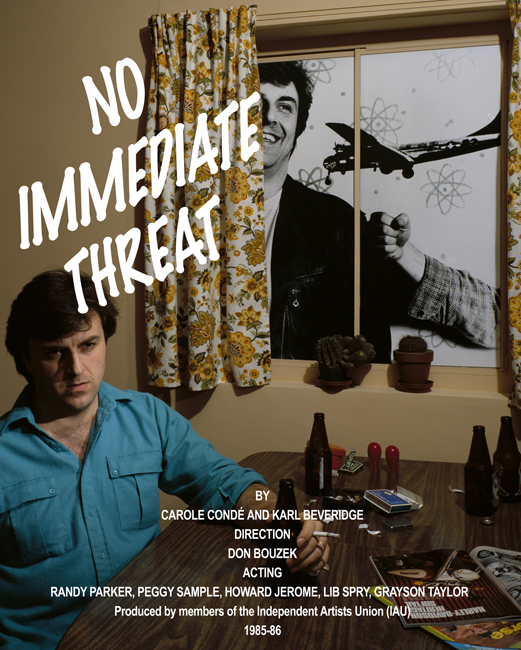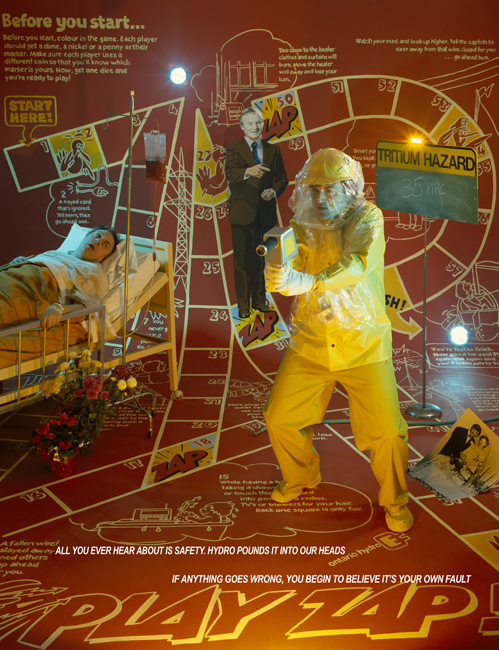No Immediate Threat (1986) is based on the lives of nuclear power workers Condé and Beveridge met through family and community networks who work at the Bruce Nuclear Power Development. But even with this more personal connection, the workers were reluctant to talk about their experience and thoughts. As a community, they are aware of the criticisms of their industry and felt very protective of their interests.
The Bruce Nuclear site, located on the Ontario shore of Lake Huron, has the largest concentration of nuclear power reactors in the world. The site contains nine separate reactors and a heavy water production facility. It is owned and operated by Ontario Hydro (*1).
The first things you notice as an outsider arriving in the community is the corporate presence of Ontario Hydro and the ‘macho’ culture of the, mostly male, workers. It was very easy, given this and our own critical views of nuclear power, to have been moralistic towards the people who worked there. It is even quite possible that elements of this attitude slipped into the final work. In the end, however, we realized that there was little difference between those who work in the industry and the rest of us. The people who work in the nuclear industry live the same contradictions, but more intensely.
What became fascinating about the project was that it acted as a metaphor for the larger world we live in. We’re all tied into our ‘jobs’ – the need to earn a living. And artists, in particular, are no exception (except that we tend to earn less). We all face the horrors of our society with a ‘macho’ indifference. The risks nuclear power workers face daily on the job are the nightmares we confront in the headlines about Sellafield, Three Mile Island, Chernobol, Elliot Lake… and do very little about. Except to grumble.
As we were completing the project, the union went out on strike. All the nuclear plants in Ontario were closed down. For a number of years Ontario Hydro management had being petitioning the Atomic Energy Control Board of Canada to license management to operate the reactors during a strike. Control operators, who are members of the union, get seven years training. It’s called seven years for seven seconds. An operator has seven seconds to shut down a reactor before meltdown. Management was seeking a license after only six months of training. Two weeks into the strike a license was issued to management. The next day the workers circulated a petition through the community protesting the license. The next day the strike was settled. There’s no hard evidence, but it seems there had been a small operational ‘incident’(*2) at the plant that night.
*1: Bruce Nuclear was sold off as part of the privatization frenzy of the 1990′s. It is now owned by a British corporation and is up for sale again.
*2: Incident is the polite word used for an accident or serious breakdown
Panel 1 Text:
Atomic energy will do more to change human life than anything else has ever done. For the first time we shall have at our command a means by which the age-old dream of plenty may be fulfilled. We may then have a chance, each according to his taste or talent, to get the most out of life. Although nurtured by war, atomic energy may yet serve to emphasize the futility of war, and thus free man from its compulsion; while the study of the sub-atomic world may enable him to learn something of the nature of the universe of which he himself is such an infinitesimal part.
In August 1945 the existence of Chalk River was made public and for the first time the people of Canada become aware of what their government had undertaken in their name. Then, however, atomic energy was almost exclusively associated in people’s minds with the bombs that had destroyed Hiroshima and Nagasaki, and it was not till much later that the Idea of atomic energy for peaceful purposes become at all general.
D.M. LeBourdals Canada and the Atomic Revolution 1959 (McClelland & Stewart Ltd.)
For the individual exposed to low-level radiation, the damage suffered is of the same kind as and not easily distinguished from that caused by natural background radiation, which none of us can escape. Natural background radiation causes us to age gradually, and increasing that background exposure will accelerate the ageing process. The wear and tear caused by radiation results in the gradual accumulation of mistakes in the body’s homeostatic mechanisms. Nor is radiation damage limited to the subtle harm done to the person exposed. It can also injure the ovum and sperm cells from which all future generations derive. This damage may range from severe to mild. Severe damage usually results in infant or childhood death, sterility or institutionalisation of the victim.
Rosalie Bertell
No Immediate Danger
1985 (The Womens Press)
—
Panel 2 Text:
There can be little doubt that Ontario Hydro is involved in an unofficial but systematic campaign to discredit, and in some cases destroy, this province’s natural wealth in hydroelectric energy. And it is clear that the head office decision to turn a cold, bureaucratic shoulder on water power is motlvoted not by economic or technical considerations but by internal power politics.
The evidence is clear enough. Hydro’s own staff have catalogued literally hundreds of undeveloped hydroelectric sites in the province, ranging in size from two to 200 megawatts. Much of this potential involves simply upgrading existing dams or redeveloping abandoned sites.
Paul McKay
Electric Empire
1983 (Between the Lines)








